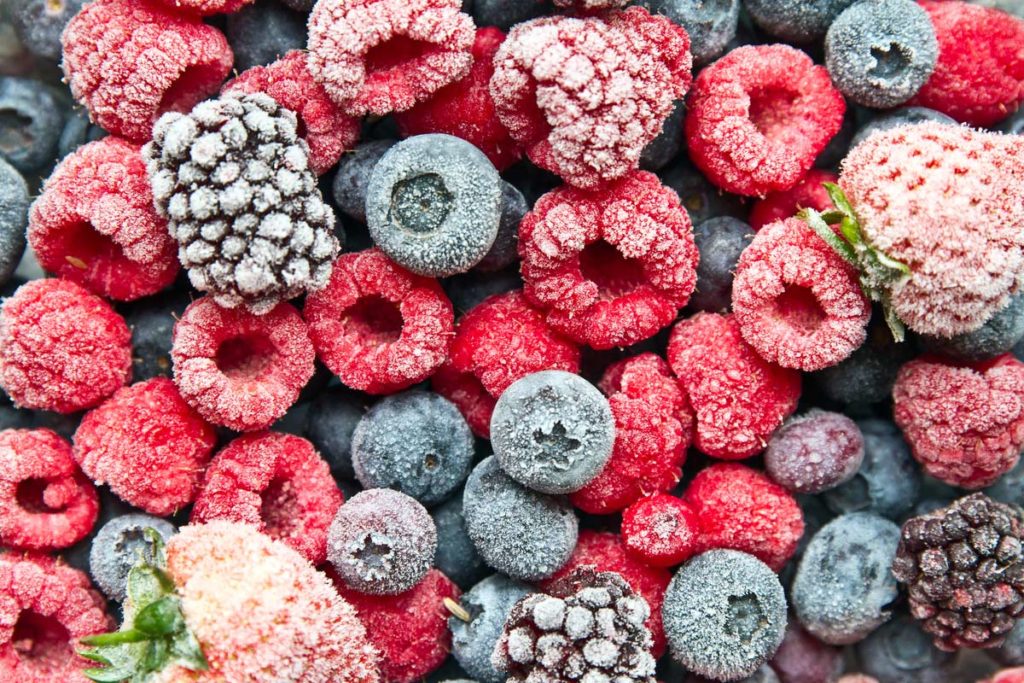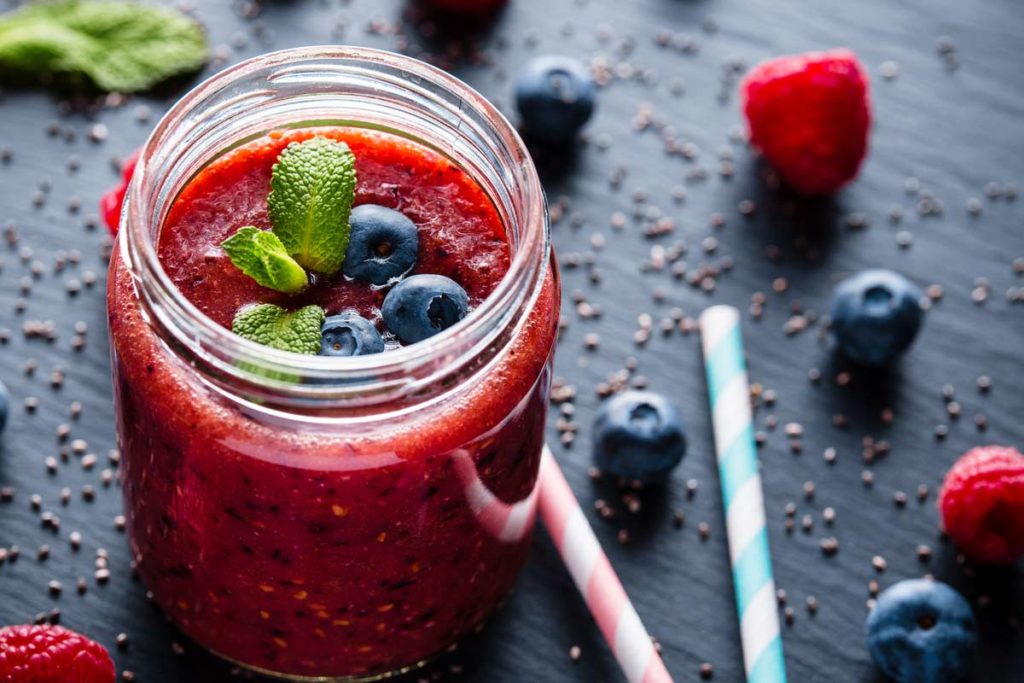Getting Started: Stock Your Fridge and Pantry with the Right Foods
Having the right foods on hand is the first step to being ready to cook healthy. Luckily, there are many food choices to provide the versatility and nutrients you need to get the most from your meals. Here are recommendations for foods to always keep on hand in your fridge, freezer, and pantry.
Protein will give you long-lasting energy and keep your muscle mass from depleting.
Eggs
The ever-modest and unassuming egg tops our list of foods to always keep on hand not only because of its excellent nutrient value and versatility but because eggs provide the best buy for your grocery budget. In 2017, you could buy a dozen large eggs for around $2.00—or 17 cents per egg. Each large egg provides just over 6 grams of what is known as complete protein. This is high-quality protein balanced with amino acids. This is important because the protein and amino acids are used by your body to produce new proteins for cell and tissue maintenance. The protein will give you long-lasting energy and keep your muscle mass from depleting (common as we age).
A breakfast that includes two eggs gives you 12 grams of protein (almost a quarter of your daily requirement) along with some extra nutrient goodies, such as vitamin D (protects bones and helps prevent osteoporosis), choline (important for brain health), and specific antioxidants which can help reduce age-related blindness.
Better still, the egg has been vindicated since The Department of Health and Human Services announced that average consumption of food such as eggs wouldn’t significantly contribute to high blood cholesterol levels. This means there’s no reason to throw away the egg yolks any longer and it’s OK to eat the whole egg again.

Whole Grains
Whole grains in your pantry are staple ingredients to cooking healthy. They add so much nutritional value to your meals such as fiber, B vitamins like thiamin, riboflavin, and niacin (great for your metabolism), and folate (known as folic acid), which keep your red blood cell count up, as well as minerals such as iron, magnesium, zinc and selenium for overall immunity and strength.
Whole grains also help your digestion and they allow you to stay feeling ‘full’ longer after your meal. Brown rice, bran, oatmeal, bulgur, barley, buckwheat, and the popular new grain, quinoa, are great additions to your pantry and are wonderful carbohydrates to incorporate into your breakfast, lunch, or dinner.
Frozen Fruits And Veggies
If you can’t get fresh vegetables regularly, we highly recommend stocking up on frozen fruits and vegetables and keeping a variety of several kinds in the freezer (un-sweetened and without any additional sauces). Frozen fruits and vegetables are convenient, healthy produce options that can be easily used in daily cooking whether it’s breakfast, lunch, or dinner. Frozen fruits and vegetables maintain their taste and high nutritional value (flash-frozen at the site of harvest which locks in the nutrients) and are pre-chopped and blanched, so you don’t need to wash or cut them.
Economically, they are great options because they are available throughout the year and often less expensive than fresh fruits. For added convenience, you only use what you need and keep the remaining veggies in the freezer for later use (up to two months once the bag has been opened). We recommend having any of the berry varieties, such as strawberries, raspberries, blackberries, cherries or blueberries, which are both are tasty and full of vitamins and minerals. Frozen peaches and mangos are also excellent choices and full of vitamin C.
Frozen green vegetables such as spinach or kale are great for your muscles and easy to use in cooking (you get more density in a frozen bag than if you buy fresh without sacrificing on flavor and vitamins). Then you have the staples, such as corn, green beans, carrots, broccoli, cauliflower, beans, Brussels sprouts, winter squash which is all terrific and essential veggies to keep on hand as they add fiber, vitamins, and great flavor and color to your meals.

Dried Fruit And Nuts
Keeping dried fruit and nuts on hand serve as both a healthy snack alternative and even as an instant boost of energy when added to breakfast porridge or salads. Nuts provide an excellent source of fiber as well as protein and healthy fats while dried fruits also packed full of fiber, adding loads of vitamins and minerals. Although dried fruits contain more sugar than the fresh versions, it’s still healthier as a source of sugar than ‘natural’ sweeteners since they are whole foods.
Nuts provide an excellent source of fiber as well as protein and healthy fats while dried fruits also packed full of fiber, adding loads of vitamins and minerals.
Great choices for dried fruits (organic if possible) include apricots, prunes, figs, cranberries, raisins, and mulberries (try to buy unsweetened organic varieties). When purchasing nuts, try and stick to unsalted, dry roasted or raw varieties—even organic if possible. Walnuts, almonds, cashews, hazelnuts, peanuts, and pistachios are all tasty options that are packed with health benefits.
Healthy Spreads
Nutritious spreads, such as peanut butter, almond butter, hummus, ricotta or cottage cheese (low-fat alternative to cream cheese) are great choices for your pantry or fridge. If you enjoy eating jam, try pure fruit spreads instead with a high fruit content and no-sugar-added. Keep honey, maple syrup, and olive oil on hand as well, as they are all flavorful and healthy additions to your meals.

Easy and Nutritious Meal Ideas
Oat Bran With Fruit
Oat bran is full of fiber and nutrients and makes a creamy, delicious breakfast cereal. This quick and easy breakfast takes only 3–5 minutes and provides a versatile, fiber-packed start to your day.
A 2017 survey revealed that almost one-third of seniors have no emergency savings and 70 percent have less than six months of savings
Directions:
- For one serving add 1/3 cup of oat bran to one cup of water.
- Bring to a boil and reduce the heat.
- Mix and let simmer for a couple of minutes (adding a bit of water if it gets too thick).
- Turn off the heat.
- Here, you can add a handful of your favorite nuts, seeds, or fruit (dried, fresh or even frozen) for some added texture, color, and nutrients. Cinnamon, ground ginger, maple syrup or honey can be added as well if you wish to add a bit of sweetness and spice.
- Pour into a bowl and enjoy!
- Try other variations of creamy whole grain cereals, such as steel-cut oats, quinoa and ground buckwheat.
Mexican Microwave Omelet
This is one of the easiest ways to make an omelet. If you have a microwave, you don’t need to worry about flipping or fussing over a stove.
Directions:
- Take a microwave-safe bowl with a wide flat bottom. The wider the bowl base, the thinner your omelet will be.
- Grease the bottom of the bowl with a bit of vegetable oil, olive oil, or non-stick cooking spray.
- Break two eggs into the bowl and using a fork beat until smooth.
- Add half a cup of thawed frozen vegetables (for this recipe we use a Mexican mix variety of corn, beans, and red peppers).
- Add a tablespoon of milk, a dash of salt and Mexican seasoning to taste (chili powder or taco seasoning works as well) and mix in with a fork.
- Cover the bowl with a paper towel or microwave-safe plate and put in the microwave. Microwave on high for 50 seconds. If the eggs seem a bit runny, you can microwave for another 20 seconds until they are fully cooked.
- Using a spatula, lift or slide onto a plate and enjoy!
- Try to make other tasty versions of this omelet by adding or switching with other fillings, such as chopped spinach, tomatoes, onions, ham, turkey, or shredded cheese.
Baked Risotto Primavera
This is an easy-bake Italian rice recipe with a nice balance of veggies, whole grains and proteins. You can change the veggie and meat selection for another variation such as broccoli and beef.
Ingredients:
- 1 cup short or medium-grain brown rice
- 3½ cups vegetable broth or low-sodium chicken broth
- 3 cloves of minced garlic *3 teaspoons of minced garlic
- 2 cups of frozen vegetables (Italian blend)
- 1 teaspoon each of dried parsley, oregano, and basil
- ½ cup of grated parmesan
- 1 pound of chopped chicken breast
Directions:
Preheat oven to 425°F. Get a Dutch oven or ovenproof high sided skillet. Heat a tablespoon of oil over medium heat and add in rice and the broth. Bring to a boil, stirring for 1 to 2 minutes. Stir in the garlic and spices and then add in the vegetables and chicken. Cover the pan and transfer to the oven. Bake until the rice is just tender—50 minutes to 1 hour. Sprinkle with parmesan cheese and serve.
Beef Barley Stew
This is a crockpot recipe, which is not only easy to use but doesn’t involve any messy stovetop cooking. Just set the timer and let it cook away. What you get is a hearty, delicious stew that tastes even better the next day!
Ingredients:
- 1 1⁄2 lb. boneless chopped beef chuck steaks (1-inch chunks)
- 2 cups chopped carrots
- 1 pound of sliced mushrooms
- 1 envelope of onion soup mix
- 2 tablespoons Worcestershire sauce
- 2 cups water
- 2 (4 1/2 ounce) cans beef broth
- 1 (14 1/2 ounce) diced canned tomatoes (don’t drain when adding)
- 3⁄4 cup uncooked pearl barley
- 3⁄4 cup frozen green peas
- salt and pepper
Directions:
Layer the carrots, mushrooms, and beef in the crockpot. Combine the onion soup mix, broth, Worcestershire, canned tomatoes, water, and barley and pour over the beef. Cover and set to cook on the setting LOW for 8 to 10 hours or setting HIGH for 4 to 6 hours. Towards the end, stir in the peas and cover once more. Cook another 20 minutes and season with salt and pepper to taste.
Berry-Boosting Smoothie

Smoothies are thick shakes easy to make and amazingly nutritious meal options for any time of the day. Smoothies can give you your daily intake of fruits and veggies, in an easily digestible and tasty beverage. The smoothie variations are endless and you can add in any mix of veggies and fruits, as well as adding seeds, nuts, and healthy liquid ingredients to boost its nutrient value.
Ingredients:
- 1 cup almond milk (or soy, rice, coconut milk if you prefer)
- 6 oz. Greek yogurt
- 1/4 cup almonds
- 1 cup frozen berries, such as blueberries, strawberries or any other variety
- 1/2 banana
- 1 tbsp of wheat germ, ground flaxseed or chia seeds
Directions:
Put the Greek yogurt, almonds, almond milk into the blender first and then add the fruits and wheat germ. Blend until mixed.
Do you want to cite this page? Use our ready-made cite template.
